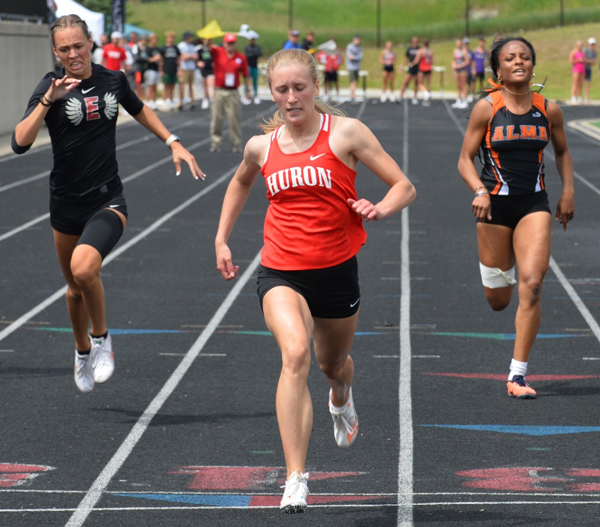
Williams Races to Place with All-Time Best
By
Paul Costanzo
Special for MHSAA.com
April 18, 2019
Bridgeport girls track coach Rick Popp said he believes his star sprinter Payten Williams has the potential to be a world champion.
 The high praise is something Williams appreciates, as she said it shows her coach has faith in her. But does the senior have that same faith in herself?
The high praise is something Williams appreciates, as she said it shows her coach has faith in her. But does the senior have that same faith in herself?
Williams was as quick to answer that as she is on the track: “Yes.”
“Payten is crazy fast,” Popp said. “She’s been the fastest girl in the state of Michigan the past two years. When you watch her run, her leg speed is insane. We don’t have a boy that can beat her in the 40 meters. The girl is just crazy lightspeed right now.”
While a world championship is a lofty goal, it’s hard to argue with Popp’s current assessment of Williams, the reigning MHSAA Lower Peninsula Division 2 champion in the 100 and 200 meters. During the past two years, she’s lost just two races, and both came at the MHSAA Finals her sophomore year. She placed fourth in both. She wasn’t unbeaten as a freshman, but she still finished first more than she didn’t and placed sixth at the Finals in the 200.
Her personal best in the 200 meters is 24.26 seconds, which she ran in July 2018 at the United States Track and Field Junior Olympics in North Carolina, placing 10th. That time would be an MHSAA Finals record in all but Division 1. Her personal best in the 100 is 12.06, which she ran at the 2018 MHSAA Finals, when she won by nearly half a second – second place came in at 12.55.
“Every state record should be gone,” Popp said, alluding to Williams breaking them. “Every all-time state record should be gone. When she’s dialed in, she’s lightspeed. She flies off her feet better than most anybody I’ve ever seen.”
Williams said she’s always been fast, but it took good coaching to help her reach these heights. That’s something she said she began to receive while in middle school from her AAU coaches, and that has continued into high school with them and Popp.
As things started to click, Williams started thinking big.
 “It felt great – it felt that I was going to become something,” Williams said. “I had a lot of people looking up to me, so I knew I had to keep going further. Making it all the way to the Olympics is something that’s big for me.”
“It felt great – it felt that I was going to become something,” Williams said. “I had a lot of people looking up to me, so I knew I had to keep going further. Making it all the way to the Olympics is something that’s big for me.”
She said she’s made a decision on which college she will be attending, but that she isn’t ready to make an announcement.
Her focus for now is on finishing her high school career strong. That includes breaking the 24-second and 12-second barriers in her respective races, although she was quick to note that the 100 isn’t really her race despite the fact she’s been dominant in it for two years.
“The 200 is my race,” she said. “I just like the race; it’s hard to explain it.”
She said that even after winning the 100 at last year’s Finals, she was more concerned with the 200 she still had to run. That doesn’t mean she wasn’t happy about the double.
“It felt great,” she said. “My mom was like, ‘You’re going to get this. You’re going to become a state champion.’ I was like, ‘No mom, don’t think that.’ But then she was right.”
The times are more important to Williams than winning races. With such lofty goals and recent championship results, focusing on racing the clock could be her best path to reaching them.
“I just focus on getting to the finish line and how I run,” she said. “I don’t think about anything else. I just think about myself and the track.”
Williams has yet to run an outdoor race this season, but she did win a pair of indoor races at Saginaw Valley State in late March, claiming the 60 meters in 7.74 seconds and the 200 in 25.41.
She said she’s been off to a slower start this season, as she’s had to devote more time to her family, specifically helping care for her grandfather. While she didn’t want to elaborate, she did say that she’s getting back to practicing full time and expects to have another strong season.
There’s plenty for her to work for, including repeat championships, state records, getting closer to her Olympic dreams, and her family.
“I’m pushing myself by using my strength as my motivation,” she said. “And I’m doing it for my granddad.”
 Paul Costanzo served as a sportswriter at The Port Huron Times Herald from 2006-15, including three years as lead sportswriter, and prior to that as sports editor at the Hillsdale Daily News from 2005-06. He can be reached at [email protected] with story ideas for Genesee, Lapeer, St. Clair, Sanilac, Huron, Tuscola, Saginaw, Bay, Arenac, Midland and Gladwin counties.
Paul Costanzo served as a sportswriter at The Port Huron Times Herald from 2006-15, including three years as lead sportswriter, and prior to that as sports editor at the Hillsdale Daily News from 2005-06. He can be reached at [email protected] with story ideas for Genesee, Lapeer, St. Clair, Sanilac, Huron, Tuscola, Saginaw, Bay, Arenac, Midland and Gladwin counties.
PHOTOS: (Top) Bridgeport's Payten Williams, far right, surges through the finish in winning the 200 meters at last year's Lower Peninsula Division 2 Finals. (Middle) Williams, middle, leads the 100 as contenders power through the final paces of that sprint. (Click to see more from RunMichigan.com.)

Multi-Sprint Champ Racing to Finish Huron Career Ahead of the Rest Again
By
Keith Dunlap
Special for MHSAA.com
May 25, 2023
NEW BOSTON – If there was one thing Elizabeth Anderson took pride in elementary school, it was simply showing that she could outrun everyone in sight.
 In fact, Anderson has an explanation for all the success she had in those playground races.
In fact, Anderson has an explanation for all the success she had in those playground races.
“Dominance when you are in elementary school,” Anderson quipped. “I don’t think I ever had a nickname. I just think everyone knew I was fast.”
Years later, pretty much everyone who follows track & field in the state of Michigan can attest to that.
A senior for New Boston Huron, Anderson has been faster than most other competitors in the state during her three-year high school career (with her freshman season in 2020 canceled due to COVID-19).
Last year, Anderson won titles at the Lower Peninsula Division 2 Finals in the 200-meter (25.07) and 400-meter (56.28) dashes, and was runner-up in the 100-meter dash (12.23).
Often, top sprinters focus on one or two of those three races. But Anderson is certainly a different breed of sprinter because she does all three.
In fact, she holds school records in all three of those events, and if all that weren’t enough, Anderson is a part of all three sprint relay teams.
“It is hard to give her events off,” said New Boston Huron head girls track coach Danielle Lobato.
Despite the different styles the 100, 200 and 400-meter dashes present, Anderson said there usually isn’t much adjusting when she goes from one of those races to another.
 The strategy is simply, “Let’s beat the other girls to the finish line.”
The strategy is simply, “Let’s beat the other girls to the finish line.”
“I don’t really go into each race changing up how I would run,” she said.
While enjoying and succeeding in all three races, Anderson said she actually does have a favorite among them.
“I would say the 400 is probably my favorite,” she said. “Even though it hurts, it’s satisfying to see how much you can get your time down in the 400 compared to any other race.”
Anderson said she started running track in sixth grade, but really got serious about it during the summer after her sophomore season, when she was invited to run for a local club.
Eventually, that led to her competing over the winter in indoor events.
She lived and breathed track so much that last fall, she decided to not run cross country so she could focus on a weightlifting regimen aimed at developing more leg strength.
“Once I started doing summer track, I realized I wanted to be doing this all the time,” she said.
Lobato said oftentimes in practice, Anderson is a de facto coach, given there is no better person she can think of for the younger runners on the team to learn from.
“I can’t always demonstrate these things I’m trying to teach,” she said. “You get to see it in real life (from Anderson), not in a YouTube video.”
After winning the 100, 200 and 400-meter dashes at her Regional meet last week, Anderson has her sights set on achieving the same trifecta of titles at next Saturday’s Finals in Grand Rapids.
Anderson has signed to run track at Michigan State, but has been plenty motivated to keep producing this spring in her final high school season.
“I’m really looking to defend my titles,” she said. “That is what is really motivating me to keep going. I want to keep in shape for the college season. I don’t want to lose any of the progress I have made. Ultimately, I just love running track.”
And since elementary school, Anderson has loved — and succeeded in — outrunning everyone else to the finish line.
“We knew we were getting something special,” Lobato said of when Anderson arrived in high school. “But you never expect this. All that she has accomplished is amazing.”
 Keith Dunlap has served in Detroit-area sports media for more than two decades, including as a sportswriter at the Oakland Press from 2001-16 primarily covering high school sports but also college and professional teams. His bylines also have appeared in USA Today, the Washington Post, the Detroit Free Press, the Houston Chronicle and the Boston Globe. He served as the administrator for the Oakland Activities Association’s website from 2017-2020. Contact him at [email protected] with story ideas for Oakland, Macomb and Wayne counties
Keith Dunlap has served in Detroit-area sports media for more than two decades, including as a sportswriter at the Oakland Press from 2001-16 primarily covering high school sports but also college and professional teams. His bylines also have appeared in USA Today, the Washington Post, the Detroit Free Press, the Houston Chronicle and the Boston Globe. He served as the administrator for the Oakland Activities Association’s website from 2017-2020. Contact him at [email protected] with story ideas for Oakland, Macomb and Wayne counties
PHOTOS (Top) New Boston Huron's Elizabeth Anderson clears the finish line during last season's LPD2 400 race. (Middle) Anderson, middle, outpaces the field to also win the 200. (Click for more from RunMichigan.com.)

